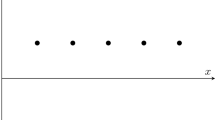Abstract
Structural equations have become increasingly popular in recent years as tools for understanding causation. But standard structural equations approaches to causation face deep problems. The most philosophically interesting of these consists in their failure to incorporate a distinction between default states of an object or system, and deviations therefrom. Exploring this problem, and how to fix it, helps to illuminate the central role this distinction plays in our causal thinking.


















Similar content being viewed by others
Notes
For an example of a similar approach that—in my view, at least—lacks the needed controls, see Yablo (2004).
I learned this useful terminology from Chris Hitchcock, whose own work on structural equations approaches clearly recognizes the importance of the default/deviant distinction. See also Maudlin (2004) for a very different approach that relies centrally on this distinction.
With, of course, the usual understanding that the dependence is “non-backtracking”: it’s not that if D had not fired, that would have been because C did not fire, hence E would have fired all the same. Lewis (1979) gives what has come to be viewed as the standard treatment of non-backtracking conditionals. I think the influence this article has had is highly unfortunate, because its approach is badly confused. See the extended version, Sect. 4.
A small technical nicety: equations must take the most “efficient” form—we can’t, for example, make B here depend on C by rewriting the second equation as \({{\bf B} \Leftarrow {\bf A + C - C.}}\) More exactly, we can say that a variable Y in the equation for X is irrelevant iff, for each way of specifying the values of the other variables in the equation, there is a value v such that the equation guarantees that X = v, regardless of the value of Y. What we require is that no structural equation contain any irrelevant variables.
The problem indicated here for accommodating backwards causation is not at all peculiar to the structural equations approach, but affects any counterfactual analysis. See Arntzenius and Maudlin (2005) for relevant details.
Halpern and Pearl’s extra condition is strictly weaker than (ii), allowing that the C-E process could have been altered by these external contingencies, so long as the alterations were in a specific sense irrelevant.
The extended version looks at structural equations treatments of late preemption, as well—too long a discussion to include here. But I cannot resist observing that there is an astonishing gap—a chasm, a Grand Canyon—between the claims that partisans of structural equations make on behalf of these treatments, on one hand, and the fallacy-ridden reality, on the other.
In Hall (2000), I labored mightily to have the contrary intuition, in order to preserve the transitivity of causation. I now think that was probably a mistake.
Halpern and Pearl (2005) think otherwise, offering a rather tortured defense of the claim that other acceptable models for switches will yield the result that the switching event is not (relative to those models) a cause of the target effect. See the extended version for discussion.
Thus I am distancing myself somewhat from the view expressed in Hall (2004c), though largely to avoid needless complication.
For a rare—and strained—disagreement, see Lewis (2004).
How might the dynamics distinguish one state as a ‘nothing happening’ state? Perhaps this way: there might be a unique state such that, if every cell has that state at some time, then given the dynamics, every cell must continue to have that state, thereafter. The idea is that the characteristic dynamical behavior of a state of the world that qualifies as a state in which nothing is happening, anywhere, is to persist unchanged. Note that in Conway’s game of “Life”, the ‘empty’ cell state has this feature, but the ‘filled’ state doesn’t.
That’s generally true of threat-cancelers: since the presence of the threat is typically extrinsic to any reasonable candidate for a sequence of causes connecting the threat-canceler to the effect, Intrinsicness will rule that they are not causes, at least of the sort that thesis aims to characterize.
Exactly the same state? No. See the extended version for discussion of this qualification, and the reasons for it.
What makes them so easy is in part that the default state—namely, non-firing—for a neuron is so clear and unambiguous, in part that this choice of default state is fixed, independently of its setting or history, and in part that there are so few deviations to keep track of. Remove any of these simplifying conditions, and the account inevitably becomes more complicated.
Not in a simple way: it’s not that we will judge C to be a cause of E iff there is a process connecting C to E. Cases of switching show that such a connection does not suffice for causation; cases of threat-canceling show that such connection is not necessary for causation.
References
Arntzenius, F., & Maudlin, T. (2005). Time travel and modern physics. http://plato.stanford.edu/entries/time-travel-phys/
Campbell, J. (2006). An interventionist approach to causation in psychology. In: A. Gopnik & L. Schulz (Eds.), Causal learning: Psychology, philosophy and computation. Oxford: Oxford University Press, in press.
Clark, P., & Hawley, K. (Eds.). (2003). Philosophy of science today. Oxford: Oxford University Press.
Collins, J., Hall, N., & Paul, L. A. (Eds.). (2004). Causation and counterfactuals. Cambridge, MA: MIT Press.
Elga, A. (2001). Statistical mechanics and the asymmetry of counterfactual dependence. Philosophy of Science, 68(3)(Supplement), S313–S324.
Hall, N. (2000). Causation and the price of transitivity. Journal of Philosophy, 97, 198–222
Hall, N., & Paul, L. A. (2003). Causation and preemption. In: P. Clark & K. Hawley (Eds.), Philosophy of science today. Oxford: Oxford University Press.
Hall, N. (2004a). The intrinsic character of causation. In: D. Zimmerman (Ed.), Oxford Studies in Metaphysics, Volume 1:255–300.
Hall, N. (2004b). Rescued from the rubbish bin: Lewis on causation. Philosophy of Science, 71, 1107–1114.
Hall, N. (2004c). Two concepts of causation. In: J. Collins, N. Hall, & L. A. Paul (Eds.), Causation and counterfactuals, chapter 9.
Hall, N. (2006). Structural equations and causation (extended version) ms.
Halpern, J. Y., & Pearl, J. (2005). Causes and explanations: A structural-model approach. Part 1: Causes. British Journal for the Philosophy of Science, 56, 843–887.
Hitchcock, C. (2001). The intransitivity of causation revealed in equations and graphs. Journal of Philosophy, 98, 273 – 299.
Hitchcock, C. (2003). Of humean bondage. British Journal for the Philosophy of Science, 54, 1–25.
Kim, J. (1971). Causes and events: Mackie on causation. Journal of Philosophy, 68, 426–441.
Lewis, D. (1973a). Causation. Journal of Philosophy, 70, 556–567.
Lewis, D. (1973b). Counterfactuals. Cambridge: Harvard University Press.
Lewis, D. (1979). Counterfactual dependence and time’s arrow. Noûs, 13, 455–476.
Lewis, D. (1986a). Philosophical papers (Vol. II). New York: Oxford University Press.
Lewis, D. (1986b). Postscripts to “Causation.” In: Lewis 1986a: 172–213.
Lewis, D. (1986c). Events. In: Lewis 1986a: 241–269.
Lewis, D. (2004). Causation as influence. In: J. Collins, N. Hall, & L. A. Paul (Eds.), Causation and counterfactuals (chapter 3).
Maudlin, T. (2003). A modest proposal concerning laws, counterfactuals, and explanation. unpublished ms.
Maudlin, T. (2004). Causation, counterfactuals, and the third factor. In: J. Collins, N. Hall, & L. A. Paul (Eds.), Causation and counterfactuals, (chapter 18).
McDermott, M. (1995). Redundant causation. British Journal for the Philosophy of Science, 46, 523–544.
Pearl, J. (2000). Causality: Models, reasoning, and inference. Cambridge: Cambridge University Press.
Ramachandran, M. (1997). A counterfactual analysis of causation. Mind, 106, 263–277.
Yablo, S. (1992). Cause and essence. Synthese, 93, 403–449.
Yablo, S. (2004). Advertisement for a sketch of an outline of a proto-theory of causation. In: J. Collins, N. Hall, & L. A. Paul (Eds.), Causation and counterfactuals (chapter 5).
Zimmerman, D. (Ed.) (2004). Oxford studies in metaphysics (Vol. 1). Oxford: Clarendon Press.
Author information
Authors and Affiliations
Corresponding author
Rights and permissions
About this article
Cite this article
Hall, N. Structural equations and causation. Philos Stud 132, 109–136 (2007). https://doi.org/10.1007/s11098-006-9057-9
Received:
Accepted:
Published:
Issue Date:
DOI: https://doi.org/10.1007/s11098-006-9057-9




